When it comes to countertop reverse osmosis systems, you’ve likely heard of these two names—RKIN and AquaTru. Both of these brands sell no-install countertop RO systems that make it easy for folks to produce their own purified water at home.
We personally tested the AquaTru Countertop Water Purification System and the RKIN U1 to compare their performance, quality, and overall value for money. Check out the head-to-head below.
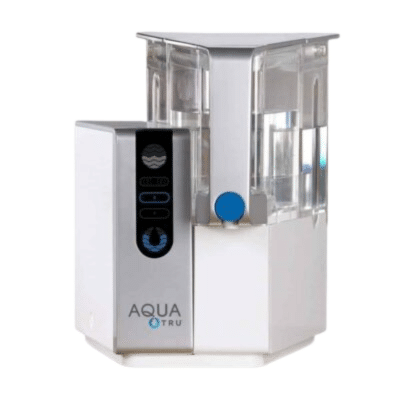
AquaTru
Best For:
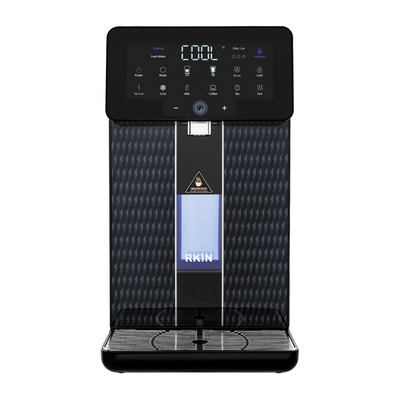
RKIN
Best For:
The concept of the AquaTru and the RKIN U1 are pretty similar: you fill the water tank and switch the system on, and within a few minutes, you’ll have access to purified RO water. Both units use an electric pump to send water through the filters and RO membrane, greatly reducing the majority of TDS.
The RKIN U1 is a good deal more expensive upfront, but we found that maintenance for both systems was surprisingly affordable, and both did an excellent job at greatly reducing or removing virtually all impurities in our water. Both were slow to dispense water, and we wish AquaTru’s base model came with remineralization (rather than this being an optional extra). We were also disappointed that the RKIN U1 isn’t performance certified.
Table of Contents
📊 Our Testing Data
We’ve established 6 main testing criteria for our water filter reviews, and we used these when ranking and comparing the AquaTru and RKIN U1 RO systems. The table below highlights our scores for both units in each of these testing criteria.
| Factor | Aquatru | RKIN U1 |
|---|---|---|
| Contaminant Reduction | 9.91 | 9.00 |
| Filtration Rate | 7.00 | 7.50 |
| Design | 9.70 | 7.50 |
| Setup | 10.00 | 10.00 |
| Maintenance | 9.75 | 9.75 |
| Company | 8.80 | 8.20 |
To obtain the overall scores for the filtration systems, we combined multiple data across a range of testing subcategories. We’ve shared this data in the next table.
| Factor | Aquatru | RKIN U1 | Winner |
|---|---|---|---|
| Overall Score | 9.59 | 8.83 | Aquatru |
| Health Related Contaminants | 9.90 | 9.30 | Aquatru |
| Aesthetic Related Contaminants | 9.90 | 9.90 | Tie |
| Performance Certification | NSF/ANSI 42, 53, 58, 401, & P473 | none | Aquatru |
| Filtration Rate | 0.04 GPM | 0.07 GPM | Aquatru |
| Component Quality | Outstanding | Good | Aquatru |
| Component Certification | NSF/ANSI 372 | none | Aquatru |
| Setup | Exceptional | Exceptional | Tie |
| Servicing Requirements | Outstanding | Outstanding | Tie |
| Costs | $0.11/ gal | $0.0809/gallon | Rkin U1 |
| Company | Good | Fair | Aquatru |
🚰 Contaminant Reduction
We used data from our own at-home testing and professional NSF/IAMPO/WQA certifications to compare the AquaTru and RKIN systems for their contaminant reduction abilities.
Our Lab Test Results
We wanted to see how the AquaTru and RKIN U1 performed when removing contaminants from our own drinking water supply, so we conducted a water quality test before and after filtering it through the systems.
For both systems, we used Tap Score test kits provided by SimpleLab. We sent our before-and-after test samples directly to the lab for in-house testing.

The table below lists the contaminants detected in our source water and compares how well the RKIN and AquaTru units removed them.
| Contaminant | Measurement | Unfiltered | Aquatru | Aquatru % Change | RKIN U1 | RKIN U1 % Change |
|---|---|---|---|---|---|---|
| Barium | PPM | 0.014 | 0 | -100.00% | 0.0087 | -37.86% |
| Calcium | PPM | 23.9 | 0.7 | -97.07% | 3.6 | -84.94% |
| Chloride | PPM | 9.2 | 0 | -100.00% | 0 | -100.00% |
| Copper | PPM | 0.0525 | 0 | -100.00% | 0 | -100.00% |
| Fluoride | PPM | 1.5 | 0 | -100.00% | 0 | -100.00% |
| Lead | PPM | 0.0009 | 0 | -100.00% | 0 | -100.00% |
| Magnesium | PPM | 6.08 | 0.36 | -94.08% | 0.39 | -93.59% |
| Molybdenum | PPM | 0.0047 | 0 | -100.00% | 0 | -100.00% |
| Nitrate (as N) | PPM | 2.1 | 0 | -100.00% | 0.2 | -90.48% |
| Phosphorus | PPM | 1.1 | 0 | -100.00% | 0 | -100.00% |
| Sodium | PPM | 9.91 | 0 | -100.00% | 1.2 | -87.89% |
| Strontium | PPM | 0.108 | 0 | -100.00% | 2.42 | 2140.74% |
| Sulfate | PPM | 7.6 | 0 | -100.00% | 1.6 | -78.95% |
| Total Dissolved Solids | PPM | 112 | 12 | -89.29% | 23 | -79.46% |
| Uranium | PPM | 0.0182 | 0 | -100.00% | 0 | -100.00% |
| Zinc | PPM | 0.559 | 0 | -100.00% | 0 | -100.00% |
Both systems got very similar results, but AquaTru got a slightly higher score because it performed the best when removing health-related contaminants from our water.
Health-Related Contaminants
We started by comparing the health-related contaminants that the AquaTru and RKIN U1 could remove.
11 contaminants with possible health effects were detected in our tap water: lead, fluoride, uranium, strontium, molybdenum, nitrate, sodium, barium, copper, zinc, and sulfate. Fluoride, lead, and uranium were the most concerning to us because they were detected at levels exceeding the Tap Score HGL.
The AquaTru system did an exceptional job of eliminating 100% of all 11 contaminants.
The RKIN U1 eliminated 8 of these contaminants, while sulfate, nitrate, and barium were greatly reduced.
There was one anomaly in our results: strontium actually increased from 0.1 to 2.42 PPM, and we think that the remineralization filter must contain traces of this impurity. It didn’t exceed the HGL of 3 PPM, so we weren’t worried by this outcome.
Aesthetic Contaminants
Around 0.5 PPM of chlorine was detected in our unfiltered city water. Chlorine is commonly found in municipal water supplies as it’s a widely used disinfectant, but it’s classed as an aesthetic contaminant because it affects water’s taste and odor.
Both the AquaTru and the RKIN U1 removed 100% chlorine from our water. We taste-tested our water post-filtration and the chemical chlorine taste was no longer detectable in either of the purified samples.
Minerals & Salts
The AquaTru and RKIN U1 use membrane separation to thoroughly purify water, so we knew that our water’s healthy minerals and salts concentrations would also be reduced post-filtration.
For our baseline test, 23.9 PPM calcium and 6.08 PPM magnesium were detected in our unfiltered water sample.
The RKIN U1 has a built-in remineralization filter, so we expected these minerals to be retained or perhaps even increased. But actually, only 3.6 PPM of calcium and 0.39 PPM of magnesium were detected in our purified water, so the remineralization filter hadn’t done a whole lot to make up for the minerals removed. Sodium was reduced to 1.2 PPM and chloride to undetectable levels.
The AquaTru Classic doesn’t come with a remineralization filter, so we were unsurprised to see that our water’s mineral concentrations were greatly reduced. The system removed 97% calcium (to 0.7 PPM), 94% magnesium (to 0.36 PPM), and completely removed chloride and sodium.
We plan to test the AquaTru with the remineralizing VOC carbon filter in the future, so we can see how effectively it reintroduces minerals compared to the RKIN U1.
Performance Certifications
We know that performance certifications are a dealbreaker for many folks – they won’t buy a water filtration system without proof that it performs as claimed by the manufacturer.
The AquaTru has been certified to NSF Standards 42, 53, 58, 401, and P473 by IAPMO. Under these certifications, the unit has been tested and proven capable of reducing 83 contaminants, including lead, fluoride, copper, TDS, PFOA/PFOS, barium, chromium, cysts, nitrate/nitrite, radium 226/228, selenium, arsenic perchlorate, estrone, BPA, and more.
RKIN is in the process of applying for an NSF certification to Standard 58 for the U1 system. We know that this process began in August 2022, but it’s not currently listed in the NSF’s database of certified water filters, or in the WQA or IAPMO databases.
We were given access to RKIN’s IAPMO testing results, which listed numerous contaminants that it had been tested to remove, including lead, fluoride, TDS, chromium III, chromium VI, and PFOA/PFOS – but these results aren’t currently available on the company’s website.
🚦Filtration Rate
The RKIN U1 and AquaTru use a pump to send water quickly through their filters, but the filtered water gets delivered from a tank, so the actual dispensing speed is pretty slow and steady.
To test the filtration rate for both systems, we timed how long it took to filter one gallon of water, then converted our data into a GPM (gallons per minute) measurement.
You can see how the filtration rates for RKIN and AquaTru compare in the table here.
| Product | Filtration Rate Score | Filtration Rate |
|---|---|---|
| Aquatru | 7.00 | 0.04 GPM |
| Rkin U1 | 7.50 | 0.07 GPM |
AquaTru did just a bit worse here – it purified 11 cups of water in 15 minutes 53 seconds, giving it a flow rate of 0.04 GPM.
The RKIN U1 performed similarly, purifying 1 gallon of water in 14 minutes, so its filtration rate was 0.07 GPM. It delivered cold and hot water almost instantly because it uses instant-hot technology, so we didn’t have to wait much longer if we wanted our water heated before dispensing.
Both systems aren’t the fastest we’ve seen – we’ve tested pressurized systems in the past that have a flow rate of 2 GPM or more.
Efficiency Ratio
A reverse osmosis system’s efficiency ratio, or recovery rate, measures how much water the system wastes per gallon of water purified. All RO systems waste some water, but modern systems like the AquaTru and RKIN units are much more efficient and water-saving.
The AquaTru is one of the most efficient countertop RO systems we’ve tested, with a 4:1 performance efficiency. That means only 1 gallon of water is wasted for every 4 gallons of filtered water produced.
The RKIN U1 isn’t quite on AquaTru’s level in this performance category. It has a 1:1 efficiency ratio, meaning that 1 gallon of water is wasted for every 1 gallon of pure water produced.
While the U1 is more efficient than the conventional reverse osmosis system with a 1:4 ratio, it’s not the best we’ve seen, and we found we were having to empty our wastewater tank more frequently than we were with the AquaTru.
💲 Upfront Cost
As we write this review, the AquaTru’s cheapest base model, the AquaTru Classic, costs $449.00. There are three configurations that you might choose to upgrade to:
- The AquaTru Connect, which connects to a WiFi app and costs $50 extra
- The AquaTru Alkaline Classic, which comes with an alkalizing mineral-boost VOC filter and costs $20 extra
- The AquaTru Alkaline Connect, which comes with WiFi app connection and an alkalizing mineral-boost VOC filter and costs $70 extra
The RKIN U1 is more expensive at $749.95, which makes sense given that RKIN offers a few unique benefits, like water dispensing at any temperature and hydrogen infusion.
We’ve noticed that RKIN usually gets involved in seasonal sales events, and we’ve seen the unit sold for as little as $550.
📐 Design
From the outside, the AquaTru has a more unconventional triangular shape, and the RKIN U1 is a large, rectangular box, a bit like a coffee maker or mini fridge. The AquaTru was the better system in terms of component quality and certifications for materials safety.
The next table shows the design scores we awarded to both systems, and the data we combined to achieve these scores.
| Product | Design Score | Component Quality | Materials Safety |
|---|---|---|---|
| Aquatru | 9.70 | Outstanding | NSF 372 certification |
| Rkin U1 | 7.50 | Below Average | Not certified |
Component Quality
The AquaTru and RKIN U1 got similar scores for component quality, but we were more impressed with AquaTru’s quality of design overall.
The AquaTru has a Tritan design, and the manufacturer says that the unit is BPA- and BPS-free. We thought that the plastic design felt sturdy but not too heavy or bulky, and didn’t seem likely to shatter.
That said, there are still studies that contest the safety of Tritan plastics, and we think that most plastics still have their flaws.
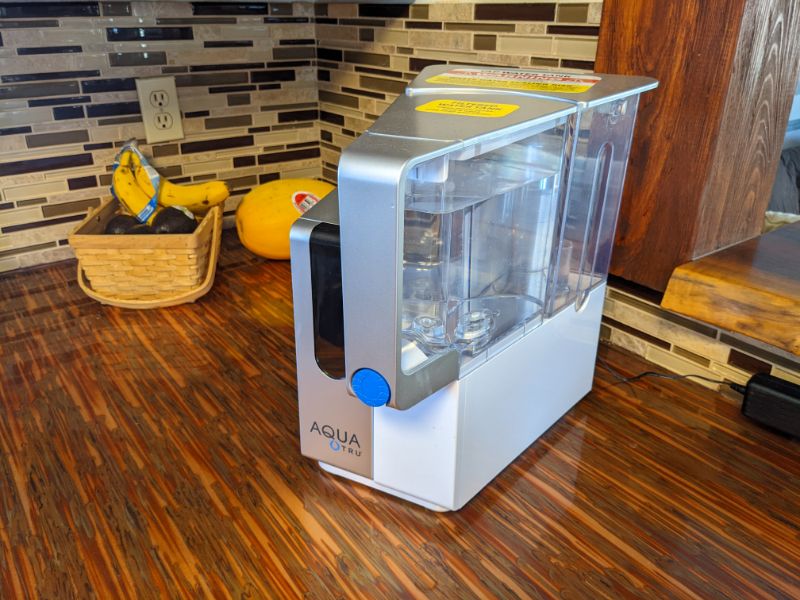
The RKIN is made from polypropylene, which is also BPA-free and is, according to RKIN, “the safest kind of plastic” to use in food and beverage storage products. Polypropylene is also heat-resistant, which is important given that the U1 heats water to 112°F.
However, like Tritan plastic, polypropylene has still been found in studies to have several possible health effects, including hormone disruption.
We know that RKIN has tried to prevent contact between the U1’s plastic components and the water as much as possible. For instance, there’s an inner silicone tube inside the nozzle, so water doesn’t touch its plastic exterior.
The U1’s water tank has an ABS (acrylonitrile butadiene styrene) design, which is also considered safe and BPA-free.
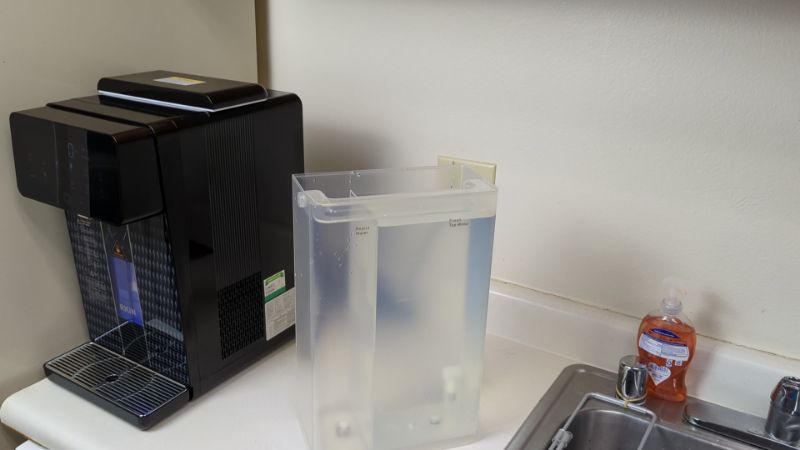
Design Setbacks
Both AquaTru and RKIN have a few specific design features that we think could be seen as setbacks by some folks.
Both systems are standalone units, which is great from a portability perspective. But because they’re not connected to a water pipe or drain line, we had to fill the tanks and empty the wastewater tanks manually for both units.
The water holding capacity isn’t great for either system: the AquaTru holds 0.75 gallons, while the RKIN U1 holds just 0.5 gallons.
Filling the U1’s tank was more of a hassle because we had to get to the back of the unit. RKIN sells a turntable for the U1, allowing you to swivel the unit without having to pull it away from the wall, but this made the U1 too tall to sit underneath our wall cabinets.
Plus, the U1’s tank was taller than our sink faucet, meaning we had to fill it with the pullout sprayer hose. We found it a bit annoying to have to stand around waiting for it to fill.
Filter Materials
AquaTru uses several filter stages, including a sediment pre-filter, an activated carbon filter, and a semi-permeable membrane.
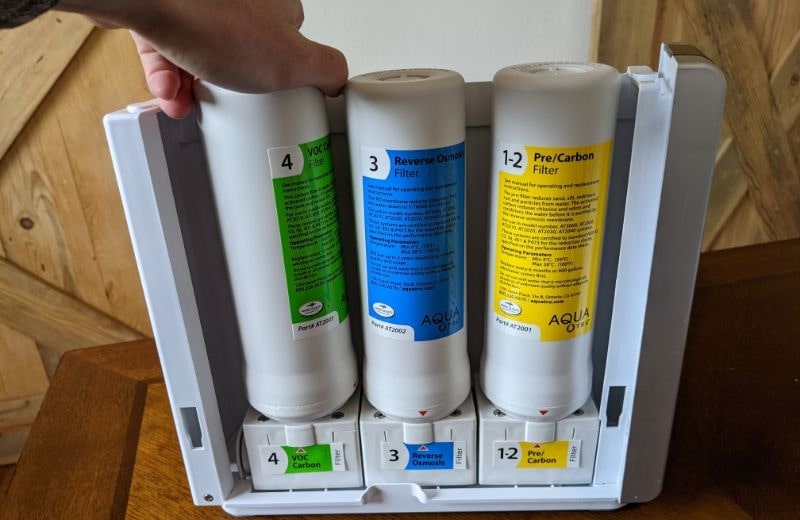
The RKIN U1 combines five filtration stages: sediment and carbon filters, an encapsulated reverse osmosis membrane, an alkaline post-filter, and a hydrogen module. The hydrogen infusion stage is what makes the RKIN U1 unique from a filter design and performance perspective, although there isn’t a whole lot of evidence to suggest that hydrogenated water is definitely better for your health.
Both systems use plastic in the filter housings.
Materials Safety Certification
Water filter manufacturers can also obtain materials safety certifications for their components to assure customers that their products are safe to use for their intended purpose.
The AquaTru holds an NSF 372 certification for lead-free design and is also certified for materials safety and structural integrity under its IAPMO performance certification, so it got the best score from us in this category.
We couldn’t find any evidence to suggest that the RKIN U1 has any certifications for materials safety.
⚙️ Setup
We timed how long it took to set up the AquaTru and RKIN systems, and compared how challenging we found their setup processes.
We’ve shared our setup scores and setup times for both units in the table below.
| Product | Setup Score | Setup Time |
|---|---|---|
| Aquatru | 10.00 | Arrived ready to use |
| Rkin U1 | 10.00 | Arrived ready to use |
We found the setup process quick and easy for both systems.
The AquaTru and RKIN U1 are plug-and-play machines, so we didn’t need any DIY skills to get them set up and ready to use. We just connected a few components, plugged the systems in, filled the water tanks, and dispensed our purified water. RKIN’s filters came pre-installed, but AquaTru’s arrived in vacuum-sealed bags, so we had to install them ourselves.
The RKIN U1 has a “flush” preset that we could initiate to rinse the filters, ensuring they were ready to use.
Priming the filters in the AquaTru was easy, too – we just ran 4 tanks of water through the system and discarded the purified water each time. The process was time-consuming but didn’t require any specialist knowledge or tools.
🔧 Maintenance
We assessed the maintenance requirements for the AquaTru and RKIN U1 by evaluating their servicing demands and ownership costs.
Our maintenance scores for both systems are highlighted in this table.
| Product | Maintenance Score | Servicing Requirements | Costs |
|---|---|---|---|
| Aquatru | 9.75 | Outstanding | $0.11/gallon |
| Rkin U1 | 9.75 | Outstanding | $0.0809/gallon |
AquaTru and RKIN were equal in this category because both have almost identical servicing requirements and filter costs.
Servicing Requirements
AquaTru and RKIN U1 are both multi-stage RO systems, so they’re a little more maintenance-heavy than other single-filter systems.
That said, we found that replacing the filters was quick and easy for both systems, and both have filter change icons on their display screens, so we didn’t have the hassle of making our own phone calendar reminders for the different filters.
Our maintenance for the AquaTru involved changing the three filters according to their schedules, cleaning the water tanks once a week with warm, soapy water, and wiping down the unit exterior with a damp cloth when needed. AquaTru also recommends flushing the unit with pure water once a week to clean the filters, although this isn’t an essential task.
The RKIN was easier to maintain thanks to its self-cleaning features, including the “rinse” setting, which drains the system and flushes the filters, and the built-in UV light, which zaps the stored water to prevent the formation of microorganisms. That meant we didn’t have to manually take apart and clean the system ourselves.
We still had to clean the outside of the unit and replace the filters. Although the U1 has more separate treatment stages, it still only uses three filters, so it doesn’t need any more filter changes than the AquaTru.
For both systems, we needed to empty the wastewater from the tank once it got full.
Maintenance Costs
Both AquaTru and RKIN have surprisingly low long-term maintenance costs.
Based on the listed filter lifespans, the overall cost for AquaTru’s filters is $0.11/ gallon. We calculated that each filter in the system costs:
- Classic Pre/Carbon Filter: $0.03/gallon
- Classic VOC Carbon Filter: $0.04/gallon
- Classic Reverse Osmosis Filter: $0.04/gallon
The RKIN U1 has an even lower overall maintenance cost of $0.0809/gallon. The three separate filter stages in the system cost:
- 2-in-1 Sediment and Carbon Pre-Filter: $0.04/gallon
- U1 RKIN AlcaPure Alkaline Post Filter: $0.04/gallon
- RO Membrane: $0.0009/gallon
That makes the RKIN U1 and the AquaTru some of the cheapest units we’ve tested from a maintenance perspective, even with their multiple filters. We’ve found that the average middle-ground maintenance cost for water filters is $0.54-0.61/gallon, so RKIN and AquaTru are refreshingly affordable in the long run – even if they’re expensive upfront.
🏢 Company
In this category, we compared AquaTru and RKIN as companies, putting their warranty offerings and their shipping and returns policies head-to-head.
The table below displays the data we used to produce the company scores for AquaTru and RKIN.
| Product | Company Score | Warranty Length | Shipping | Returns |
|---|---|---|---|---|
| Aquatru | 8.80 | 1 year | Free shipping to all 50 states, Canada, and Puerto Rico | 30 days |
| Rkin U1 | 8.20 | 1 year | Free shipping on orders over $175, and only to the lower 48 states | 30 days |
AquaTru got the highest overall score because it offers a better shipping policy than RKIN.
Warranty Length
AquaTru backs its products (excluding the filters themselves) with a 1-year limited warranty against defects in materials and workmanship. Customers need to cover shipping and processing fees if they get their system repaired or replaced under the warranty.
RKIN also provides a 1-year warranty to customers who have a purchase receipt, and there’s no restocking fee unless returns are made after the 30-day return window. You can buy a 1-year extended warranty for an extra $60.
Shipping
AquaTru offers free shipping to all 50 states, Canada, and Puerto Rico, so it got the best score in this category.
RKIN offers free shipping, but only on orders over $175, and only to the lower 48 states.
Returns
Both the AquaTru and the RKIN U1 can be returned within 30 days of the purchase.
However, AquaTru customers have to pay for the return shipping fees, and from what we can tell, RKIN only offers store credit in exchange for returns.
⛔️ System Setbacks & Flaws
We identified a few setbacks and flaws with the AquaTru and RKIN U1 that are worth comparing.
AquaTru Setbacks
- Expensive – Even the cheapest AquaTru model costs around $450.
- Remineralization not included – AquaTru’s base model doesn’t come with a remineralization filter; this feature costs extra.
- No hydrogen infusion or hot water dispensing – The AquaTru is missing a few of RKIN’s unique features, so it’s not quite as versatile.
- Slow water dispensing – We noticed the dispensing speed got slower as the filtered water tank emptied.
RKIN Setbacks
- Expensive – The RKIN U1 is one of the most expensive countertop RO systems we’ve come across.
- Not performance certified – While RKIN has obtained third-party testing, the U1 isn’t certified by the NSF, IAMPO, or WQA for its performance.
- Poorer efficiency ratio – RKIN’s efficiency ratio doesn’t match up to AquaTru’s and means the wastewater tank needs to be emptied more often.
- Only one model available – You have to pay for the additional features, including remineralization, hot water dispensing, and hydrogen infusion, even if you don’t think you’ll use them.
🆚 AquaTru or RKIN: Which One’s for You?
There are a few situations that we think the AquaTru or the RKIN are best suited to.
We Recommend AquaTru to:
We Think the RKIN U1 is Best For:
Found this review helpful?
Comment below or share this article!

